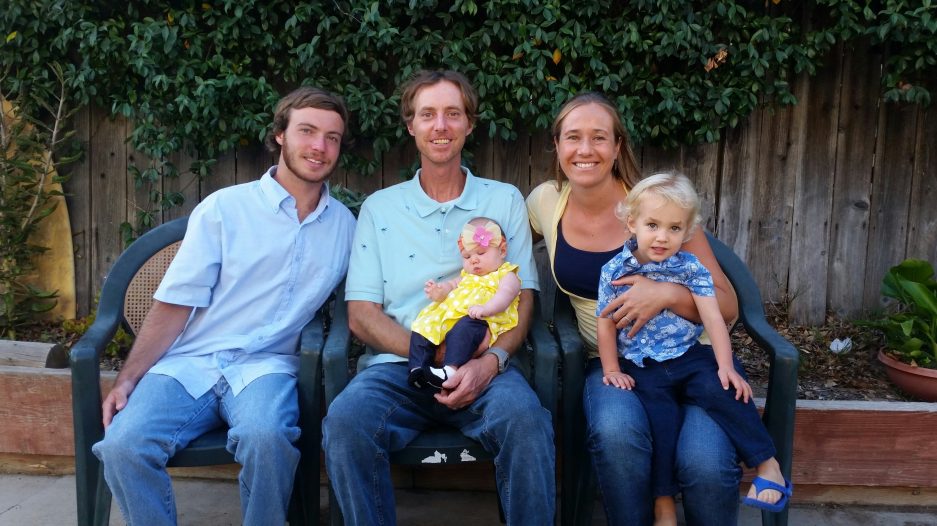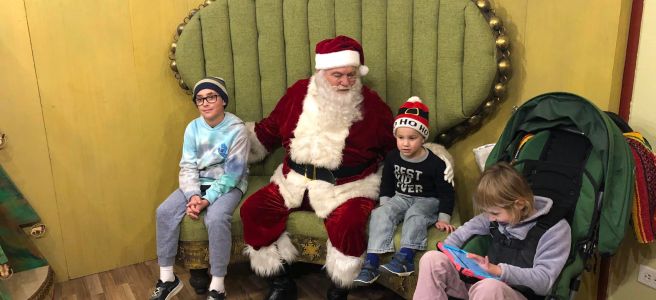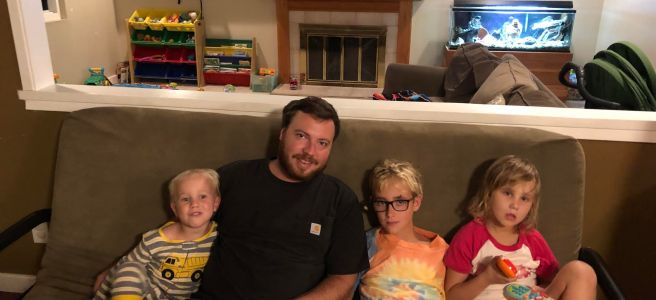This past weekend we went to the Wild Holidays event at the Safari Park. We chose this event as one of our family holiday events because it combined music and lights — two of our daughter’s (who has Dup15q syndrome and is autistic) favorite things. Santa was also making an appearance (a bonus for our toddler!).
During the event our boys (9 and 3) were saying things like, “Let’s come back. This is really fun.” As I watched Coral, I couldn’t help but wonder if she was enjoying the event. She spent most of the time looking down and not looking around at the lights, as I might have expected her to. Then, we went through the bridge of lights — a long bridge that surrounded her with lights. As we walked on the bridge, Coral commented on her AAC, “Like holiday.”
I turned to Tom, “She likes this! She just told me.”
In that same moment, I remembered something that Coral taught me many years ago: It is important for me to be open to Coral participating in an event in the way she enjoys — no matter how far from my expectation that falls.
It was a reminder to approach this holiday season with awareness, flexibility, curiosity and joy. I know that embodying this approach can feel challenging, as the holidays are a time of super charged expectations that often differ wildly from reality. Routines change (including two to three weeks without school). Sensory overwhelm abounds. Invitations to inaccessible events often arrive. Holiday foods are different. Comparison to other families’ seemingly perfect holiday photos can evoke many emotions and feelings. The result? A perfect storm for parents of disabled children (and dare I say for all parents). And this storm is not a holly jolly North Pole snow flurry with Santa. If you know this storm, you know.
So what can be done to find a bit more of the “happy and merry” in the holidays? I have compiled a short list of reflections and changes to consider — ones that have the potential to increase moments of connection, curiosity and joy. (Spoiler alert: I think this list can apply to any parent, whether your kids are disabled or not.)
1) Expectation, Reality, Story
Write down a parenting expectation about the holidays, followed by the reality (try to stick to the facts about what happened) and end with your story about the facts (this is the part where our brains start layering thoughts and feelings on top of the reality). Complete this list for as many expectations as you’d like. An example from my list is below:
Expectation: The kids all decorate the tree.
Reality: Tate and Cruz decorate the tree, while Coral plays in the living room. She watches Super Simple Songs Christmas edition and plays with her favorite music and lights toys.
Story: Gosh, it’s disappointing that Coral doesn’t put the decorations on the tree. I wish she wanted to participate in this family event. In other families, the kids always want to decorate the tree.
The power in making a three-part list like this is that it allows me to take some of the pressure off of the expectations around the holidays. In my example, when Coral is playing in the living room, she is content. Does she actually have to decorate the tree? Or do I just feel like she should want to decorate the tree?
I can more clearly see the difference between what is happening (reality) and what my brain tells me about what is happening (my story and the comparisons my story makes to an expectation). The point of this exercise is not to feel badly about having expectations or certain feelings about them not being met. It is to give me more operating space around the expectation — to allow my brain to flexibly view the expectation and the reality without jumping to so many stories.
2) Be Flexible with Holiday Traditions
There will be certain holiday traditions that are important to your family — ones you want to maintain. If these traditions/activities are ones your disabled child struggles with or seems uninterested in, can you find a way to make the activity meaningful to your child? Can you make changes that would help your child participate? If not, can your child do something different while you participate in the tradition?
During the Christmas tree decorating described above, once the boys had finished, Coral came over to the dining room. She walked over to the tree and took an ornament off, holding it close to her eye to observe every detail. I then showed her how I could put an ornament ON the tree. Off, on, off, on. Coral was interacting with the tree and ornaments in a way that made sense to her and that she enjoyed. Holiday cheer in action.
Having a flexible and curious mindset helps to release some rigidity around a tradition. I can then be more open to seeing possibilities I may not have seen before.
3) Start New Traditions
In creating new traditions that Coral will (hopefully) be interested in, I start by connecting with who Coral is and what she enjoys. To do this with your child, these are some questions you can ask:
What is important to our family during the holiday season?
What brings my child joy?
What does my child enjoy doing?
In which type of environment does my child thrive?
What environments are challenging?
What accommodations will my child need in order to participate in this activity?
After answering these questions for our family and Coral, we knew we wanted to do a couple of things together as a family because it brings Coral joy to be with us. To identify what activities would work, we thought about what she enjoys (music, lights, riding in her wagon, swimming, and Sesame Street top the list). As we worked through the list of questions, we decided upon the Wild Holidays event and the Sesame Place Christmas event. We have passes to both of these places, so attending these events is free for our family (a win-win!).
Another new tradition we plan to try this year are wagon rides around the neighborhood to look at Christmas lights. Additionally, Tom decorated our backyard with beautiful Christmas lights. We think Coral would enjoy an evening jacuzzi swim with a backdrop of these Christmas lights.
If I may propose a radical holiday tradition — don’t do anything extra. Slow down the rushing energy. Be together at home. Don’t make any specific plans. Enjoy time observing your kid(s) play — getting a precious peek into who they are becoming. Play with your kid(s). Enjoy each other.
4) It’s Okay to Say No
I grew up with a wonderful and rich tradition of a large Polish Christmas Eve celebration. It was a joyous gathering of our whole family with delicious food and tasty drinks. When Coral was younger we still attended the Christmas Eve event. However, as Coral has gotten bigger, more curious, more mobile (yet still without environmental safety awareness) and more sensitive to sensory stimulus, we have declined attending the event.
Attending an event that is extremely difficult for Coral is a quick way to be launched into a parent caregiver holiday vortex of stress and exhaustion. I’ll pass. My family loves Coral. I know if they could make accommodations for her, they would. It’s simply not feasible, given the location and type of event. (We also have our travel and sleeping accommodations for Coral to consider.)
In coming to the decision to attend or decline holiday event invitations that could be hard for your child, it is important to recognize what is behind the decision. Is the decision to attend fueled by guilt, a sense of obligation and/or habit energy related to these two? Or is the decision made only after thoughtful consideration is given to your child’s needs, your needs as a parent caregiver and the needs of each family member? Will this decision strengthen your regulated internal state, or will the result be added stress that takes away from a joyful holiday season?
No one can answer any of these questions for you. Taking time to sincerely reflect in stillness and quiet will lead you to make the best decision in that moment.
In the case of our Christmas Eve family gathering, declining the event is a decision that honors both my caregiver capacity and Coral’s needs.
5) Begin a Daily Gratitude Practice
Numerous scientific studies have found that having and expressing gratitude to others can have positive effects on both emotional health and relationships. During the holiday season, which can bring its own stressors, a daily gratitude practice can help bring us outside of ourselves, strengthening the feeling of connection with others.
Try writing down a few things each morning or evening for which you are grateful. Notice how your body feels as you contemplate your gratitude. Alternatively, begin or end times of meditation or prayer with gratitude for specific people or occurrences.
Express gratitude to people throughout the day, both those you see and interact with daily and those who you may not see again. Doing this has the potential to bring you outside of your internal story and into remembering your interconnected nature.
As you journey through this holiday season, try to maintain a self-compassionate and open approach when trying any of these practices, reflections or considerations. Everything does not have to be done at once. Small changes in awareness and reflection can have large impacts over time. Hopefully, some of these ideas bring more moments of connection and joy to your home, as they have to ours.
Thank you for reading! I will be launching a newsletter with short ideas and strategies to bring more awareness, connection and joy to (what can often feel like) a challenging parenting journey. Please consider subscribing to the blog and/or emailing elaine.keswick@gmail.com (Subject: Newsletter) to be added to the newsletter list.


